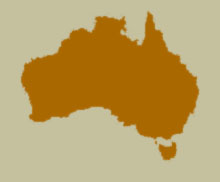Synonyms
Chilocorus malasiae Crotch, 1874: 187.
Chilocorus australasiae Gadeau de Kerville, 1884: 71.
Chilocorus Baileyi Blackburn, 1890: 1275.
Chilocorus flavidus Blackburn, 1892: 239.
Chilocorus diadema Weise, 1898: 228.
Chilocorus nasicornis Korschefsky, 1944: 52.
Diagnosis
The projecting clypeus will distinguish most males from all the other species of Chilocorus. The colour pattern of this species is very variable and can be very similar to Ch. maculatus, but the largely yellowish pronotum in combination with the almost entirely blackish elytra, where the yellow marks are not very well defined and usually absent at the apex, and the pale brownish venter distinguish this species from Ch. maculatus.
Description
Length 3.8-4.8 mm. Male. Head entirely yellowish; pronotum entirely yellowish or with a distinct blackish or piceous area medially and along the posterior margin. Elytra variable from uniformly blackish to yellow with all intermediate stages; venter yellowish. Head strongly depressed between eyes; with a distinct set of long erected hairs across inner border of eyes; weakly micro reticulate between punctures; punctation obsolete, present only in the clypeal lateral extension. Eyes dorsally separated by slightly less than 2 times the width of an eye; inner ocular margin nearly parallel. Antennomere 8 long, about as long as 6th and 7th combined. In bigger males clypeus conspicuously projecting forward at middle, the projection somewhat bidentate at apex, but in smaller specimens clypeus without projection. Terminal maxillary palpomere slightly expanded toward apex; terminal labial palpomere elongate, about 3 times longer than basal width, about as long as preceding segment. Pronotal surface polished between punctures; punctation smaller than eye facets, approximately 2 diameters apart, obsolete on anterior angles; lateral border rounded; prosternum short, slightly shorter than prosternal process widest width. Elytral surface polished between punctures; punctation stronger than on pronotum, slightly deeper and denser, about as large as or larger than eye facets, much larger at lateral margin forming a irregular row across the margin; epipleural foveae conspicuous. Abdomen with ventrite 6 very short, slightly emarginate at apex; surface of ventrite 1 micro reticulate between postcoxal lines.
Male
Tegmen relatively short, about 1/2 the abdomen length; penis guide distinctly shorter than parameres; parameres densely setose at apex, the setae short; strut slightly longer then tegmen.
Female
Female differs from male by having the clypeus not projecting forward and for being conspicuously punctuated on head.
Variation
UNDER CONSTRUCTION
 Distribution and Biology
Distribution and Biology
This is a widely spread species, commonly collected in northern Australia, New Guinea and adjacent islands. Label data shows that Ch. malasiae is associated with armoured scale insects. Along with Ch. circumdatus this species is commercially available from the Australasian Biological Control Inc. Association of Beneficial Arthropod Producers as "blue Chilocorus" to be used against many target scales mostly in citrus orchards.
Species References
Blackburn, T. 1890. Further notes on Australian Coleoptera, with descriptions of new species. Proceedings of the Linnean Society of New South Wales, Series 2, 4: 1247-1276.
Blackburn, T. 1892. Further notes on Australian Coleoptera, with descriptions of new genera and species. XII. Transactions of the Royal Society of South Australia, 15: 207-361.
Crotch, G R. 1874. A Revision of the Coleopterous Family Coccinellidae. E. W. Janson, London. xv + 311 pp. Gadeau de Kerville, H. 1884. Descriptions de quelques espèces nouvelles de la famille des Coccinellidae. Annales de la Société Entomologique de France, 6e Séries, 4: 69-72, pl. 4.
Korschefsky, R. 1944. Neue altweltliche Coccinelliden (Coleoptera: Coccinellidae). Arbeiten über morphologische und taxonomische Entomologie aus Berlin-Dahlem, 11, (1): 47-56.
Slipinski, A. and Giorgi, J.A. 2006. Revision of the Australian Coccinellidae (Coccinellidae). Part 6. Tribe Chilocorini. Annales Zoologici (Warszawa), 56(2): 265-304.
Weise, J. 1898. Ueber bekannte und neue Coccinelliden. Archiv für Naturgeschichte, 64/1(2): 225-38.
[ Top ]
